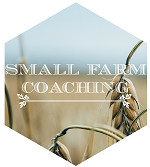*Ahem*. I got really behind in doing the BBC didn't I? I'm surprised y'all didn't start throwing tomatoes, or ranting and raving madly, or just leaving! Do you want me to start reeling off excuses, or shall I just pick up where I left off? Hmm, I'm going with the latter choice.
But I will say this! It's REALLY hard to take pictures of a chicken single-handedly when the bird gets to 5 lbs. or more. And it's also hard to take pictures when it's raining non-stop. And this particular person doesn't like to blog when she doesn't have pictures. (oh, do those count as excuses??)
But I'm going to blog without pictures anyway. This is getting ridiculous, how long I've stretched this out!
So, where on earth did I leave off?? Hmm, looks like Week #6 was the last update you got... Ouch. That was November 1st!! But on that last post, the Freedom Rangers were each averaging 3 lbs. live weight, and they were officially off grain and on to their milk/cheese/sprout diet. So in this stretch of silence, what happened??
I'm going to spit out the piece of news that you probably want to hear the most: It worked. In the end, the alternative diet worked. And it worked AMAZINGLY.
Things got really crazy after week #6 because I began drying my cow up, and the goats dried up. So I had to start relying on frozen milk, frozen cheese, and frozen whey that I had stored up. The fodder was also starting to grow slower and slower since we were getting into the cold months. But I had enough of everything to get me to week # 12.
So, week by week, what on earth happened with those birds!?
Let's start back at week #6 for a recap:
Weights at that time were 3 lbs. per bird in my group, and roughly 1.5 lbs. per bird in my friends' group.
I had no idea how much to feed these birds, or how much of each thing, so I was totally going on gut instinct, and watching the birds to see how they did. In the end, the fodder was free fed; meaning I tried to keep it in there at all times, so that they always had food in front of them. With the 25 Freedom Rangers, at 6-7 weeks of age, I was going through 6-8 lbs. of fodder a day. I didn't have a lot of cheese, since my dairy animals had just failed me (thank you 'o cow and goats! Right when I needed you! *insert unamused look*), so I only fed that to them 2x's a day, and gave 1-2 lbs. at each time. One gallon of milk made 2 lbs. of cheese, so it was easy enough to know that each gallon I got would create a day's worth of food. I alternated between the milk and whey, so that I wouldn't run out of either one too fast. For that though, I would fill a 1-gallon poultry waterer with a 1/2 gallon of milk and the birds were allowed to drink that. I experimented with taking away their water for a few hours at a time so that they only had access to the dairy, but I don't think I would do that in the summer time when the birds have heat stress to deal with. I found that the birds would only drink a 1/2 gallon of milk/whey each day; anymore than that and it would just sit and spoil.
Week #7:
The birds had officially been on the alternative diet for 2 weeks, and weights were as follows:
My group:
Average individual weight: 3.5 lbs.
Friends' group:
Average individual weight: 2 lbs.
Week 8:
My group:
Average individual weight: 4 lbs.
Friends' group: 2.3 lbs.
This is where things got crazy... The birds were eight weeks old, full feathered, and had minds of their own. They started flying out of their brooder boxes and getting into each others. If it wasn't for the weight difference, and the fact that my birds were bigger, there would have been no way to tell who's birds were whose! I was getting really stressed out with 52 chickens running rampant in my barn; it wasn't a good situation! I was on the last week in milking my cow and ultimately that's what caused a snap. I was milking once a day, and as soon as I turned on the milking machine and hit the point where I really couldn't leave the cow, in came 30 to 40 Freedom Rangers, all trying to get Mattie's feed!! This was an absolute no-no; birds of any sort are NOT allowed in the milking stall. I put my Freedom Rangers in a kidding pen that was empty, but had no where to put my friends' 27 birds! So I ended up having to give their birds back to them, and finishing my project with only my birds.
Week 9:
Average individual weight: 4.5 lbs.
Average group weight: 112.5 lbs.
Week 10:
Average individual weight: 5 lbs.
Average group weight: 125 lbs.
Week 10 was about when their appetites really began to pick up. Fodder consumption increased to an easy 10 lbs. a day, and they probably would have eaten more. I was no longer giving it as a "free feed" because we were now heading into the beginning of December, and my fodder was getting harder and harder to grow. Milk and cheese consumption stayed the same though. The cheese really seemed to make an impact on their weight gain; I noticed that without the dairy, they didn't do as well. Next time I do this, I would like to try experimenting with feeding more cheese; maybe 6-8 lbs. a day per 25 birds. Just to see if it increases growth rate noticeably or not.
Week 11:
Average individual weight: 5.5 lbs.
Average group weight: 137.5 lbs.
Week 12:
Average individual weight: 6 lbs.!
Average group weight: 150 lbs.
By 12 weeks, the birds were big enough to be butchered. They were the same weight that my Cornish X's hit at 8-9 weeks. It cost me $700 to raise one hundred Cornish X's in the traditional feeding manner (grain. Expensive grain.). Raising one hundred meat birds on the alternative diet would only cost $84. I don't know about you, but I'll take that second price over the first one. I went through a bag and a half of whole wheat for sprouting, and the milk was extra that otherwise would have been dumped because I had no room for it in the fridge.
So, where are those Freedom Rangers right now? Um... Wreaking havoc in my barn. *sheepish look* Yeah, they're still on the hoof. December turned out to be extremely busy for the local processors, and they couldn't fit me in anywhere until January. Then when January came, I didn't have the funds at the moment to be butchering them all. Time sort of just rolled by after that... And they're still here. Hehe. But personally, that really says something about the Freedom Rangers. With the Cornish Crosses, I am SO sick of those birds by 6 weeks. By eight weeks of age I hate them so much that it ain't funny. I've never gone more than 9 weeks with a Cornish X. The Freedom Rangers are now something like 5 months old, and they've been a lot of fun to keep around. The females should begin laying soon, and I suppose I really should get the males butchered before they figure out how to crow!!
Average weight at 5 months? 13 lbs.! These birds are HUGE!
All in all, I would say my Basic Broiler Challenge was a success. I set out to see if meat birds couldn't be fed more cheaply, and I found that they could. I want to order some Cornish X's (yes, even though I hate them) soon and see about raising a test batch of maybe 50 birds on the alternative diet. Since these birds need a higher octane feed than the FR chickens, I think I might see about giving them fermented grain as well, since that's such a high protein. Chicken sells well around here; I just need to figure out how to make it cost effective to raise them! And if this alternative diet idea works with the Cornish X's like it did for the Freedom Rangers, then this could be a very good side business to have along with the dairy...
So, week by week, what on earth happened with those birds!?
Let's start back at week #6 for a recap:
Weights at that time were 3 lbs. per bird in my group, and roughly 1.5 lbs. per bird in my friends' group.
I had no idea how much to feed these birds, or how much of each thing, so I was totally going on gut instinct, and watching the birds to see how they did. In the end, the fodder was free fed; meaning I tried to keep it in there at all times, so that they always had food in front of them. With the 25 Freedom Rangers, at 6-7 weeks of age, I was going through 6-8 lbs. of fodder a day. I didn't have a lot of cheese, since my dairy animals had just failed me (thank you 'o cow and goats! Right when I needed you! *insert unamused look*), so I only fed that to them 2x's a day, and gave 1-2 lbs. at each time. One gallon of milk made 2 lbs. of cheese, so it was easy enough to know that each gallon I got would create a day's worth of food. I alternated between the milk and whey, so that I wouldn't run out of either one too fast. For that though, I would fill a 1-gallon poultry waterer with a 1/2 gallon of milk and the birds were allowed to drink that. I experimented with taking away their water for a few hours at a time so that they only had access to the dairy, but I don't think I would do that in the summer time when the birds have heat stress to deal with. I found that the birds would only drink a 1/2 gallon of milk/whey each day; anymore than that and it would just sit and spoil.
Week #7:
The birds had officially been on the alternative diet for 2 weeks, and weights were as follows:
My group:
Average individual weight: 3.5 lbs.
Friends' group:
Average individual weight: 2 lbs.
Week 8:
My group:
Average individual weight: 4 lbs.
Friends' group: 2.3 lbs.
This is where things got crazy... The birds were eight weeks old, full feathered, and had minds of their own. They started flying out of their brooder boxes and getting into each others. If it wasn't for the weight difference, and the fact that my birds were bigger, there would have been no way to tell who's birds were whose! I was getting really stressed out with 52 chickens running rampant in my barn; it wasn't a good situation! I was on the last week in milking my cow and ultimately that's what caused a snap. I was milking once a day, and as soon as I turned on the milking machine and hit the point where I really couldn't leave the cow, in came 30 to 40 Freedom Rangers, all trying to get Mattie's feed!! This was an absolute no-no; birds of any sort are NOT allowed in the milking stall. I put my Freedom Rangers in a kidding pen that was empty, but had no where to put my friends' 27 birds! So I ended up having to give their birds back to them, and finishing my project with only my birds.
Week 9:
Average individual weight: 4.5 lbs.
Average group weight: 112.5 lbs.
Week 10:
Average individual weight: 5 lbs.
Average group weight: 125 lbs.
Week 10 was about when their appetites really began to pick up. Fodder consumption increased to an easy 10 lbs. a day, and they probably would have eaten more. I was no longer giving it as a "free feed" because we were now heading into the beginning of December, and my fodder was getting harder and harder to grow. Milk and cheese consumption stayed the same though. The cheese really seemed to make an impact on their weight gain; I noticed that without the dairy, they didn't do as well. Next time I do this, I would like to try experimenting with feeding more cheese; maybe 6-8 lbs. a day per 25 birds. Just to see if it increases growth rate noticeably or not.
Week 11:
Average individual weight: 5.5 lbs.
Average group weight: 137.5 lbs.
Week 12:
Average individual weight: 6 lbs.!
Average group weight: 150 lbs.
By 12 weeks, the birds were big enough to be butchered. They were the same weight that my Cornish X's hit at 8-9 weeks. It cost me $700 to raise one hundred Cornish X's in the traditional feeding manner (grain. Expensive grain.). Raising one hundred meat birds on the alternative diet would only cost $84. I don't know about you, but I'll take that second price over the first one. I went through a bag and a half of whole wheat for sprouting, and the milk was extra that otherwise would have been dumped because I had no room for it in the fridge.
So, where are those Freedom Rangers right now? Um... Wreaking havoc in my barn. *sheepish look* Yeah, they're still on the hoof. December turned out to be extremely busy for the local processors, and they couldn't fit me in anywhere until January. Then when January came, I didn't have the funds at the moment to be butchering them all. Time sort of just rolled by after that... And they're still here. Hehe. But personally, that really says something about the Freedom Rangers. With the Cornish Crosses, I am SO sick of those birds by 6 weeks. By eight weeks of age I hate them so much that it ain't funny. I've never gone more than 9 weeks with a Cornish X. The Freedom Rangers are now something like 5 months old, and they've been a lot of fun to keep around. The females should begin laying soon, and I suppose I really should get the males butchered before they figure out how to crow!!
Average weight at 5 months? 13 lbs.! These birds are HUGE!
All in all, I would say my Basic Broiler Challenge was a success. I set out to see if meat birds couldn't be fed more cheaply, and I found that they could. I want to order some Cornish X's (yes, even though I hate them) soon and see about raising a test batch of maybe 50 birds on the alternative diet. Since these birds need a higher octane feed than the FR chickens, I think I might see about giving them fermented grain as well, since that's such a high protein. Chicken sells well around here; I just need to figure out how to make it cost effective to raise them! And if this alternative diet idea works with the Cornish X's like it did for the Freedom Rangers, then this could be a very good side business to have along with the dairy...
So. Questions?









13 comments:
This sounds very interesting, I would like to try something like this but I have a hard time justifying $12.00 per gallon milk to be used for chicken feed. I would have to take into account on expense side of the ledger how much it costs to keep the cow to supply the milk, and my labor costs to milk, electricity for milking machine etc., and I can sell my raw milk so to use that for chicken feed would keep my costs high for raising the chickens :(
Is this an end run around Oregon's raw milk laws and the liability of raw milk in general - you know selling raw milk as pork/chicken since it's fed to pigs and meat chickens instead?
Looking forward to a final costs and profit or loss post when you butcher them.
Thanks.
Anonymous, I run a herdshare program with my dairy animals, so no, feeding the milk to meat animals isn't a loophole I've created to get around the law. But I often have milk that would otherwise get dumped down the drain because I have high producing animals. Feeding it to meat animals has created another bit profit for me.
I'm curious about taste... Whether the dairy made the flavor if their meat any different or any more tender. Guess we won't know that til they're butchered though! I'm surprised you don't do your own... Or do Oregon laws not allow you to sell a home-processed bird? If you did your own, it seems that would cut your costs more. We did our first couple of excess roosters using Joel Salatin's method a few weeks ago. Since it was our first time, it took around 2 hours from setup to clean up for just two Roos, but I didn't think that was awful. And we don't have a super cool Salatin scalder or plucker!
Speaking of Salatin, I know you've read all of his books. I just ordered Pastured Poultry for Profits. Do you have any recommendations as far as which of his books I should read next? I have a feeling ill eventually make it through them all as well, but I'd love your input.
Thanks!
-Nikki
I've processed my own birds for the last 3 years, but I've always rented the equipment since I'm usually butchering around 100 birds at a time. And I used to work at a poultry processing facility (i.e. a small slaughterhouse), so I'm fast as butchering now! LOL. But I haven't done these birds because I don't have the equipment (scalder, plucker, kill cones, chill trough, etc.), and prefer not to butcher without the stuff. I'm spoiled, I guess. Hehe. It does save a lot of money to do it myself, but for this year's meat birds, I've decided to take them to the processor. I can't butcher them by myself, and don't have any help to do it. So I just pay up and deal with it. :-/
All of Joel's books are awesome!! If you're wanting another "how-to" type of book to read next, then I would highly, highly recommend 'You Can Farm'. If you're wanting something educational and amusing to read, I might suggest either 'The Sheer Ecstasy of Being A Lunatic Farmer', or 'Folks This Ain't Normal'. They're all good though. :)
Thank you SO much for your recommendations! I was looking at "You Can Farm" next :)
Love following along with you on your farming adventures. I even share your stories with my husband. I laughed at the early stories of Mike and Bacon, (I hope to one day have pastured Tams myself), I cried when The calf was born dead, I cried more when Mattie died, and I celebrated after your visit with the neighbor. I'm looking forward to hearing the stories to come as you take on this new farming adventure. :)
-Nikki
Thanks for the update I wondered how your BBC turned out - it was a very interesting variation on their diet. I plan to start my first small flock this spring - Salatin style too. I don't have dairy animals so will not be able to try feeding that but do want to try the fodder -it sounds like a great cost saver on the grain.
Heads up to all Salatin fans - he is going a 3 day seminar in Canada next wk and it will also be available as his first ever Webinar. Day 1 is on You Can Farm, Day 2 is Pastured Poultry and Day 3 Salad Bar Beef. These are How To courses - each full day is $110 or $220 if you want to be able to download the seminar afterwards and be interactive and ask questions. They encourage groups to the Webinar at the same fee. In my province there are groups forming where everyone pays the local "Host" $20-25 a day to offset the cost - a great idea and spreads the word more on the Salatin method.
http://vergepermaculture.ca/blog/events/joel-salatin-live-stream-event/
So what exactly did you feed them and how much? We are getting some Cornish Cross and certainly would like to go for the lower price feeding.
We had problems with the Cornish Cross growing so fast that their bones couldn't keep up. The feet and legs would deform and cripple them. I started adding a tablespoon of cod liver oil along with milk to their feed for the first month and that cured it.
This sounds good to get weight on fast, and save money! I would also wonder about the flavor, and if it would work for laying hens? Would their long-term health be ok?
Caitlyn, this is really interesting...I'm finding this post, obviously, WAY after you wrote it, but I'm going to poke around here more to see if you already blogged answers to my Q's and some of the ones about the taste of the birds on this diet. Bryan's done lots of poultry processing, too...not as much as you, but he got pretty good at it. :-) He was wondering about a few things regarding the grain you used for comparison...organic? I need to get your phone # so we can just call you one of these days to chat! We'll get you up to Farm on the Hill for that visit, and we can pick each other's brains for a while! Hope you're enjoying your Thanksgiving weekend, and these last few days at home before your internship starts!
Blessings,
Lori
I'm so excited to have found this post! My friend and I are starting 50 Cornish X in March. They will be in tractors on pasture. We too plan on experimenting with feed. Besides oyster shell we plan on feeding half of them barley fodder only and the other half 7 lbs. of feed and 5 lbs of fodder. My studies have found barley fodder to have 23% protein at 7 days old. I'm hoping to have heavier but less fatty birds. I'm basing the amount of feed on the birds need for .25 pound of feed a day or 14 lbs in 8 weeks. Glad to find others looking for more healthy, economical ways to raise broilers.
I'm so excited to have found this post! My friend and I are starting 50 Cornish X in March. They will be in tractors on pasture. We too plan on experimenting with feed. Besides oyster shell we plan on feeding half of them barley fodder only and the other half 7 lbs. of feed and 5 lbs of fodder. My studies have found barley fodder to have 23% protein at 7 days old. I'm hoping to have heavier but less fatty birds. I'm basing the amount of feed on the birds need for .25 pound of feed a day or 14 lbs in 8 weeks. Glad to find others looking for more healthy, economical ways to raise broilers.
We are looking at other feed options for our meat bird this year. We are planning on doing some black soldier fly larvae, and now that we have a milk cow, we may start this.
When you first started, what was the difference in the amount of starter feed you and your friend were feeding? Could this have accounted for the weight difference?
How fatty were the birds once butchered?
We love the FRs! We raised 380 last year and the freedom ranger hatchery in Pennsylvania is awesome in every way. We kept 7 that didn't make weight as layers and they produce duck size eggs. The only problem is that they still have the meat bird appetite, so I keep them separate from our regular layers at feeding time and only give them a certain amount of feed. But boy do those girls range! They have gotten up to almost a quarter mile away. I have found that singing to them makes for a friendlier bunch. I have a couple of blog posts about my 2 favorites, Agnes the rooster and Pee-Wee the tiny hen.
Thanks for the info and I will keep checking back.
Serena. Stuartfarm.com
Post a Comment